How to make the most successful loaves in your bread machine
5 bread tips for home bakers.


Editor's note, June 2023: We've slightly updated this post, including photography, to provide even more guidance for readers. Time to get baking!
Do you bake bread in a bread machine?
Many bakers do, judging by the popularity of our bread machine recipes. And for good reason: The bread machine is a great way for first-time bread bakers to get started. And for seasoned bread bakers, it can be a welcome shortcut when you simply don't have time to bake bread the standard way: Simply pop ingredients into a machine like the Zojirushi Virtuoso and let it do all the work, from mixing to kneading to rising to baking.
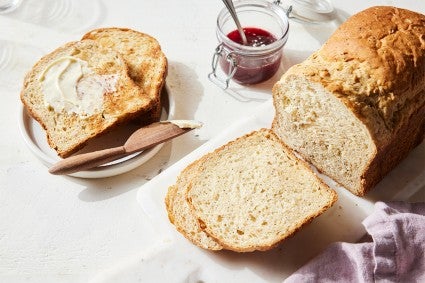
It would be great if the bread machine's chief product — sandwich loaves — would come out perfect every time. Beautifully risen, symmetrically domed, a lovely crust with no floury spots. But honestly? That's not the reality of bread machine baking. What you save in time and effort, you often lose in quality, including mishappen loaves or bread with those dreaded holes in the bottom from the bread machine's paddles.
But with just a minimal amount of effort, you can step in and help your bread machine as it kneads and shapes and bakes — thus ensuring yourself a higher percentage of perfect (or nearly so) loaves. You just need to be willing to touch the dough.
(Fair warning: If you're someone who likes to "set it and forget it" — add the ingredients, press Start, and come back 3 hours later — then this post isn't for you.)
Let's make some bread. We'll go with our most popular bread machine recipe: Bread Machine Bread — Easy As Can Be.
Begin by putting everything into the bucket of your bread machine. Putting the liquids in first makes the dough (and baked bread) less prone to floury spots.
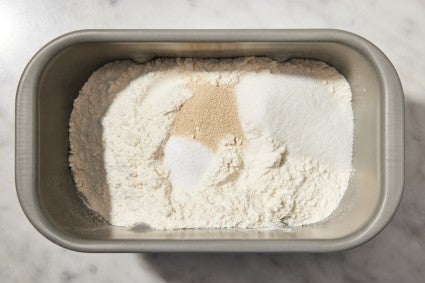
So many people seem afraid to "interfere" with their bread machine as it works. But honestly, nothing bad will happen if you open the lid and poke at the dough.
Start watching the dough about 10 minutes into its kneading cycle; it shouldn't be viscous and liquid-like, nor dry, stiff, and "gnarly." As fellow blogger Susan Reid says, "If you touch the dough and your finger comes back coated, the dough is too wet. If you touch the dough and it feels like poking a beach ball, it’s too dry."
The dough should have formed a cohesive unit and, if not "smooth as a baby's bottom" yet, should be headed in that direction. If it's not, add more flour (if it's too soft), or water (if it's dry).
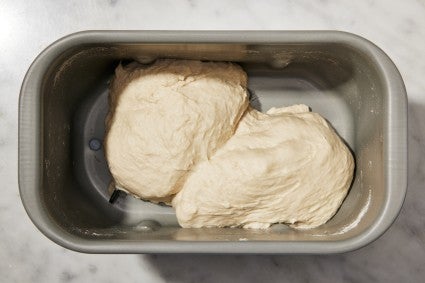

This step takes just a few seconds and will help prevent floury spots on the baked loaf's crust.
The timing for this can be a bit tricky; but once you figure it out, you're good to go forever.
Get out your kitchen timer, and put it in count-up (stopwatch) mode. Start your timer when you press "Start" on your bread machine (even if your machine has a "rest" or "preheat" mode right at the beginning); you're simply trying to gauge the amount of time between when you press start, and when the final rise begins.
You want to be around when your bread starts its final rise. Most bread machine manuals show a timeline of steps: e.g., preheat 31 minutes, knead 19 minutes, first rise 35 minutes, second rise 20 minutes, etc. A little simple arithmetic will give you an idea of when the final rise will start.
Hang around the kitchen when you figure that final rise is imminent. You'll hear the machine start up momentarily; it'll be knocking down the dough, which means the final rise is about to begin. When you hear that happen, stop your timer and check the time. (On our Zojirushi Virtuoso, it's 1 hour, 45 minutes).
So there you have it: You now know, for the next time you bake bread, that 1 hour, 45 minutes (or whatever) will elapse between the time you press "Start" and when the final rise begins. So whenever you make bread-machine bread and want to remove the paddles before the loaf bakes — pull out your timer and put it to good use.
Reach into the bucket, move the dough aside, and lift out the paddles.
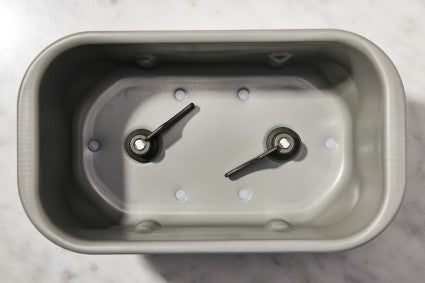
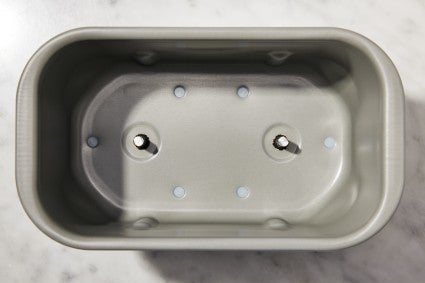
This step will result in loaves of bread without that noticeable divot at the bottom.
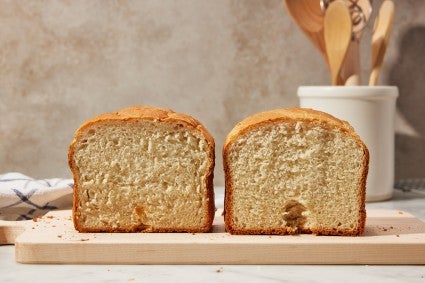
This is where you prevent ski-slope loaves — unevenly shaped bread that's much higher on one end than the other. When you open the lid of the machine to remove the bucket's paddles, check out the shape of the loaf. It might be just fine, filling the pan from end to end. Or it might look like this:
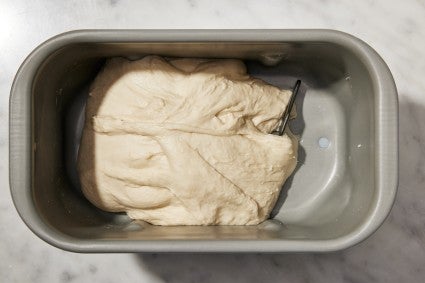
If the dough isn't in an acceptable loaf shape, take it out of the bucket, shape it into a nice, symmetrical log, and put it back into the bucket.
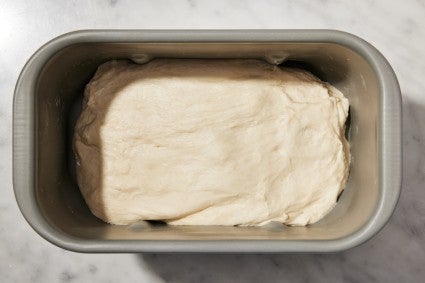
It will rise nice and evenly and bake into a lovely loaf.
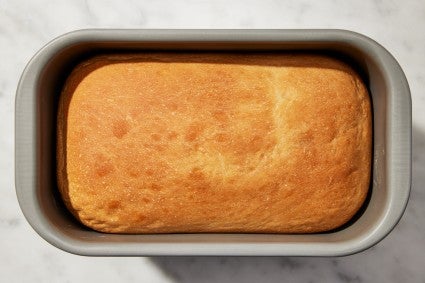
Isn't it annoying when you've done everything right, and your loaf still comes out looking ... well, not as good as it could?
You've pulled your gorgeous loaf out of the pan, and within minutes it develops a crust as wrinkled as Yoda. What's up with that? And how do you prevent it?
As soon as your bread is done, remove the bucket from the machine, take out the bread (which will be easy, since the paddles aren't there to impede its progress), and gently set the loaf back into the machine, sans bucket. Note: While setting the loaf back into the machine without its bucket is a reasonable option with our Zojirushi machines, it may not work well in other brands' machines. Let experience with your own machine be your guide here.
Crack the lid open an inch or so, and let the bread cool right in the turned-off machine. The still-warm (but gradually cooling) air helps prevent moisture from condensing on your loaf's surface — no wrinkles!
So, what's the baking science behind this? If your loaf hits the cooler air outside the machine, any moisture migrating from inside reaches the top surface and condenses, forming water droplets that cause the crust to shrink unevenly — in other words, to wrinkle.

Final step: Enjoy your wonderful homemade bread. Who says you can't bake a perfectly acceptable loaf right in your bread machine?
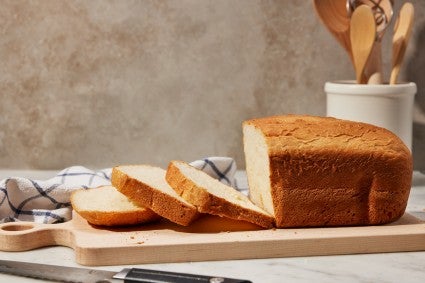
If you're looking for a great bread machine, our Zojirushi Home Bakery Virtuoso Plus Bread Machine has over 300 five-star reviews and is a beloved appliance for many King Arthur employee-owners.
Cover photo by Kristin Teig; food styling by Liz Neily.
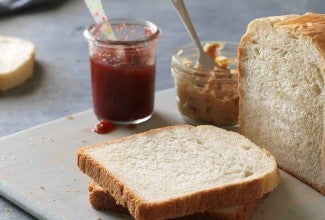


March 9, 2021 at 11:51am
In reply to Adding to the answer to your… by Frauke Facchini (not verified)
Hi Frauke, determining when a loaf of bread is fully baked is a skill that comes with practice. I use color, weight, and structure to test my loaves. Look for three colors ranging from light tan, to rich amber, to dark brown. If the loaf is pale all around, it probably needs additional baking. You can pop the loaf out of the pan toward the end of the suggested bake time. Pick the loaf up. This loaf should feel lighter than you would expect. This is an indication that enough water has been evaporated from the interior of the loaf. If it feels heavy, give it some more time by placing back in the oven directly on the oven rack. Give the loaf a squeeze. The loaf will have a solid crust all around the loaf which does not easily compress. This test needs to be done directly out of the oven and so I recommend using gloves. As your loaf cools, the moisture still remaining in the interior will migrate out of the loaf through the crust and soften it. Once completely cool, the crust should re-harden. If too much moisture is still left, the crust will be softer than desired and the inside may be gummy.
January 6, 2021 at 7:56am
What a great video, answered all my problems, going into the kitchen now
to start a new No paddle loaf. Peter
January 2, 2021 at 3:10pm
new to bread making. I have a Cuisinart Automatic Bread maker that my son gave me. I am 82 years old and have a hard time seeing th e window with the information
My son gave me a Cuisinart automatic bread maker for Christmas. I would love to make good bread for me and my friends. Any tips on using a bread maker?
Cuisinart
January 7, 2021 at 4:29pm
In reply to new to bread making. I have… by Pat (not verified)
Hi Pat! The blog post above includes tips for making bread in a bread machine! If you'd like some recipes to try out, you can find our recipes here. Be well and happy baking!
January 1, 2021 at 12:47pm
Hi,
I was given a Zojirushi V20 bread machine. When I leave the paddles in my bread is perfect. The past two times, I removed the paddles prior to the final rise and the top of the bread caved in about an inch. What do I need to do to stop this.
January 12, 2021 at 4:20pm
In reply to Hi, I was given a Zojirushi… by Pat (not verified)
We're sorry to hear that you're having some trouble, Pat! We wonder if the loaf just needs to be shaped a bit tighter — check out our How to Shape a Sandwich Loaf video for some tips. We hope this helps and happy baking!
January 1, 2021 at 12:41pm
HEY!!!!! I'm pretty diligent at making bread in my machine.. Once or twice a week.... The Grand Canyon size hole in the bottom of the loaf has irritated me FOREVER... What a simple thing to do... Remove the paddle after the kneading step... I think I'm heading for the closet to severely reprimand myself for not seeing the OBVIOUS as I remove it every loaf to clean out any crust that got stuck... Maybe I'll beat my head against the wall, while I'm in there contemplating other fundamental punishments.. I'm shaking my head as I type this... As the saying goes.... You just can't fix stupid... maybe, dumb as a rock... how about, out of my element in the baking department.. yeah, that's it...
THANK YOU SOOOOOO MUCH FOR FIXING MY BREAD LOAF !!!!!
December 28, 2020 at 9:25am
I have a Sunbeam bread machine. Had it for many years, got it out this week to make dough for pizza and breadsticks. The instructions for all the recipes calls for bread flour, I used all-purpose flour, is this okay, or do I did to make an adjustment? Also, did not get 2 pizza crusts or 30 breadsticks from the recipes.
January 6, 2021 at 3:48pm
In reply to I have a Sunbeam bread… by Debra J Stromer (not verified)
Hi there, Debra! It's just fine to use all-purpose flour in a bread machine. Without knowing more about your recipe it can be tricky to help troubleshoot, but if you'd like to chat about it please do feel welcome to reach out to our Baker's Hotline folks at 855-371-BAKE (2253)!
December 16, 2020 at 12:48pm
Hi, I've tried several bread recipes and my bread always comes out too heavy and dense. When I do it by hand without the machine it's fine. My yeast is good and the flour is fresh so what am I doing wrong? I put the ingredients in just like Zo says to do. I like a lighter fluffier bread. Even the sourdough bread machine for the 1lb loaf on this website was so heavy and dense I couldn't eat it. Please help!
Thank you!
Pagination